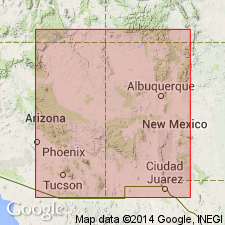
- Usage in publication:
-
- Andrecito member
- Modifications:
-
- Original reference
- Dominant lithology:
-
- Limestone
- AAPG geologic province:
-
- Basin-and-Range province
- Orogrande basin
Summary:
Pg. 11 (fig. 4), 12-13, passim. Andrecito member of Lake Valley formation. Proposed for basal member of Lake Valley formation (redefined). At type section, consists of approximately 35 feet of thin-bedded gray fossiliferous limestone grading upward into thin-bedded dark-gray somewhat cherty limestone. Varies in thickness and lithology throughout area of exposure; thickens northward from type section to over 75 feet in Rich Rim and thins again toward north end of range; maximum thickness approximately 270 feet in Cooks Mountains. At type section, underlies Alamogordo member and unconformably overlies Caballero formation; overlies various units of the Devonian in areas where Caballero is missing -either Contadero formation or Box member of Percha shale. Age is Early Mississippian (Osage).
Type section: along south wall of Andrecito Canyon, in NW/4 sec. 8, T. 18 S., R. 4 E., San Andres Mountains, [Dona Ana Co.], southern NM.
Source: US geologic names lexicon (USGS Bull. 1200, p. 97-98).

- Usage in publication:
-
- Andrecito Member*
- Modifications:
-
- Biostratigraphic dating
- AAPG geologic province:
-
- Basin-and-Range province
- Orogrande basin
Summary:
Is basal member (of six) of Lake Valley Limestone in southwest NM. Columnar sections at Bear Mountain, Grant Co, and in North Cooks Range, Luna Co (both in southeastern Basin-and-Range province) and at Lake Valley, Sierra Co (western Orogrande basin). Unconformably overlies Upper Devonian (Famennian) Box Member of Percha Shale at Bear Mountain and North Cooks Range; unconformably over Lower Mississippian (Kinderhookian) Caballero Formation at Lake Valley. Underlies Alamogordo Member of Lake Valley. Biostratigraphic dating with foraminifers yields zone pre-7 (Kinderhookian, Lower Mississippian) microfossil zone of Mamet. Regional correlations on fig. 2; is correlated with Bugle Member of Keating Formation in lower part of Escabrosa Group in Pedregosa basin. Age is Kinderhookian (Early Mississippian).
Source: GNU records (USGS DDS-6; Denver GNULEX).
For more information, please contact Nancy Stamm, Geologic Names Committee Secretary.
Asterisk (*) indicates published by U.S. Geological Survey authors.
"No current usage" (†) implies that a name has been abandoned or has fallen into disuse. Former usage and, if known, replacement name given in parentheses ( ).
Slash (/) indicates name conflicts with nomenclatural guidelines (CSN, 1933; ACSN, 1961, 1970; NACSN, 1983, 2005, 2021). May be explained within brackets ([ ]).

